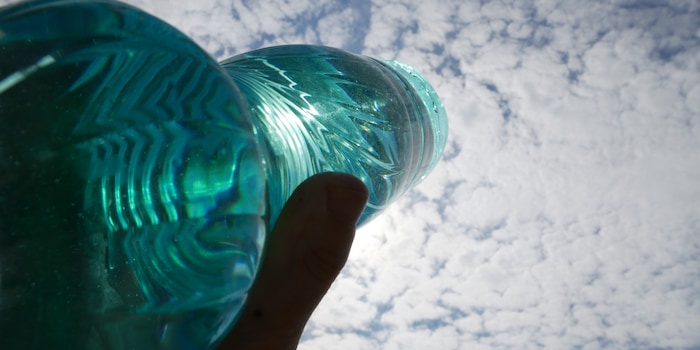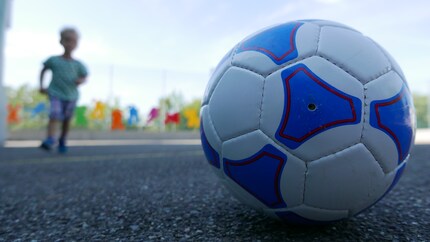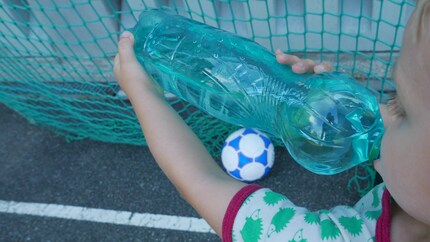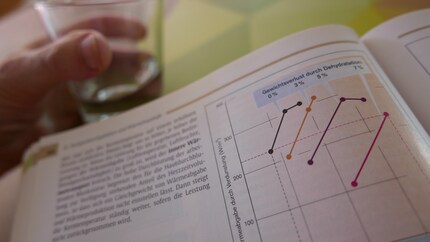
The hydration hype unveiled
When you exercise and sweat, your body loses fluids and electrolytes that need to be topped up again. So far so simple. However, determining which drink does this best is almost a religious question. But it needn’t be.
When I was ten or eleven years old, my football coach would give me a tablet during half time. Nothing immoral, it wasn’t medicinal or doping. It was just one of those fizzy multi-vitamin tablet you dissolve in water. But combined with the coach’s wise words, it felt like magic potion. Fast forward a few years and I would mix Isostar powder into my water bottle – this made me feel even more professional. After all, it was the stuff pros sipped on in the TV ads. It was the real deal. Isotonic and stuff.
No need for anything special
My bubble was burst during a physiology lecture when I was still a student of sports science. The hydration recommendations for your average athlete were far from magic:
• (Mineral) water thatis rich in potassium, magnesium and has a high sodium content (400 to 600 mg/l) puts back in whatever you sweated out. A perfect drink for workouts of around 60 minutes.
• After longer workouts of approx. 60–80 minutes, you should add carbohydrates to your the above-mentioned water. Simply mix fruit juice and water at a 1:3 ratio – water being the main part.
Isotonisch? Hypertonic? Hypotonic?
«Isotonic» has turned into a buzzword used for all sports drinks. A drink can be labelled isotonic when the ratio of nutrients to water corresponds to that of your blood. This makes it easier for your body to process it. That’s the magic. Drinks with a high sugar content, such as fruit juice or cola, are hypertonic and actually take water away from the body because your body has to dilute them. Pure tap water without the required sodium content is hypotonic and dilutes your blood. Drinking from the tap is not a problem if you’re exercising «normally». However, if you’re an endurance athlete and given extreme conditions, it can be dangerous. Marathon runners and triathletes have been known to die from brain oedema as a consequence.
It’s fairly simple: Drink when you’re thirsty
«Daddy, I want water» is a sentence my three-year old son hardly ever uttered. Much to my delight, this has recently changed during the heatwave when we're at the local sports ground. Well done, little one!


For elderly people and children, thirst tends to be a poor advisor. For everyone else, it’s pretty reliable. Nonetheless, how often and how much you should drink during sports is still much discussed and recommendations keep changing. Just a few decades ago, coaches imposed a strict drinking ban for athletes (not a great idea). More recently, things have gone the other way and there has been a «precautionary» hydration fad: 200 millilitres every 15 to 20 minutes is the name of the game.
Surely not a bad rough guide. But what about your body’s natural feeling of thirst? Don’t worry, it generally kicks in at the right time – roughly when the percentage of water in your body drops by 0.5 per cent. That’s long before fluid loss is critical. For this reason, today’s recommendation is to listen to your body. In line with this, the Swiss Sports Nutrition Society has published a hydration calculator (in German) that allows you to keep your liquid intake in check. In other words, trust your thirst but double check it.
What happens when you’re dehydrated
Losing more fluids and electrolytes than you’re putting back into your body is what is referred to as dehydration. Slight dehydration is when you’ve lost 3 to 5 per cent of your body weight. If the number goes up to double digits, you’re in trouble. A further increase can even be life-threatening. Signs of progressive dehydration are:
• Thirst (the point you need to act)
• Dry skin and mucous membranes
• Headache
• Cramps
• Heart palpitations
• Low blood pressure
• Circulation problems
• Impaired consciousness

So what about sports drinks?
There’s no magic in these potions other than their marketing: All the colourful power, super, isotonic drinks that promise amazing performance. But all they are is a mix of water, minerals and (fruit) sugar – often more than your average athlete actually needs. There are studies that prove their effectiveness. Others are trying to prove that the drinks industry is behind these studies and the results are doubtful. In any case, they are pretty pricey and definitely not more magic than a homemade diluted juice drink. However, they are huge sponsors of events such as the football world championship, during which players were only allowed to drink Coca-Cola-owned Powerade. After all, those 11-year olds are watching closely, just as I did back in the day.
As the Official Sports Drink of the FIFA World CupTM and the only sports beverage present on the field, Powerade will be there, fuelling players from all 32 teams as they battle it out on the global stage for football’s biggest prize. Powerade - Chosen by FIFA to hydrate the players of the 2018 FIFA World CupTM.
In the round of 16 against Denmark, the Croatian team «cheated» on their drinks sponsor and chugged a non-authorised beverage. This might have been the most expensive sports drink ever – it was served with a hefty fine of 70,000 Swiss francs. All I can say is cheers to that with a homemade sports drink. It’s all you need. Anything else contains too much sugar and sugar is far from being magic. Everybody knows that.
Simple writer and dad of two who likes to be on the move, wading through everyday family life. Juggling several balls, I'll occasionally drop one. It could be a ball, or a remark. Or both.
Practical solutions for everyday problems with technology, household hacks and much more.
Show all